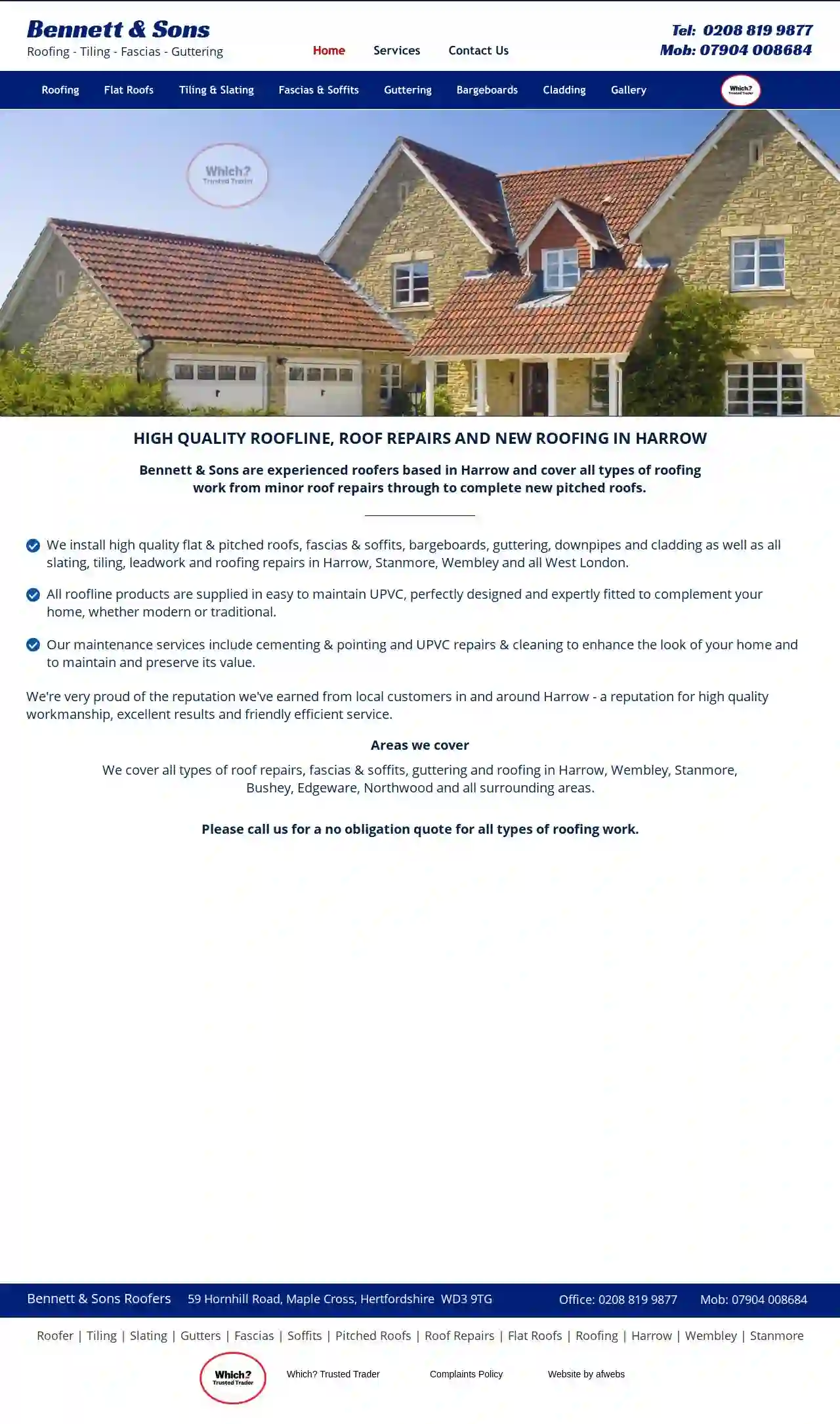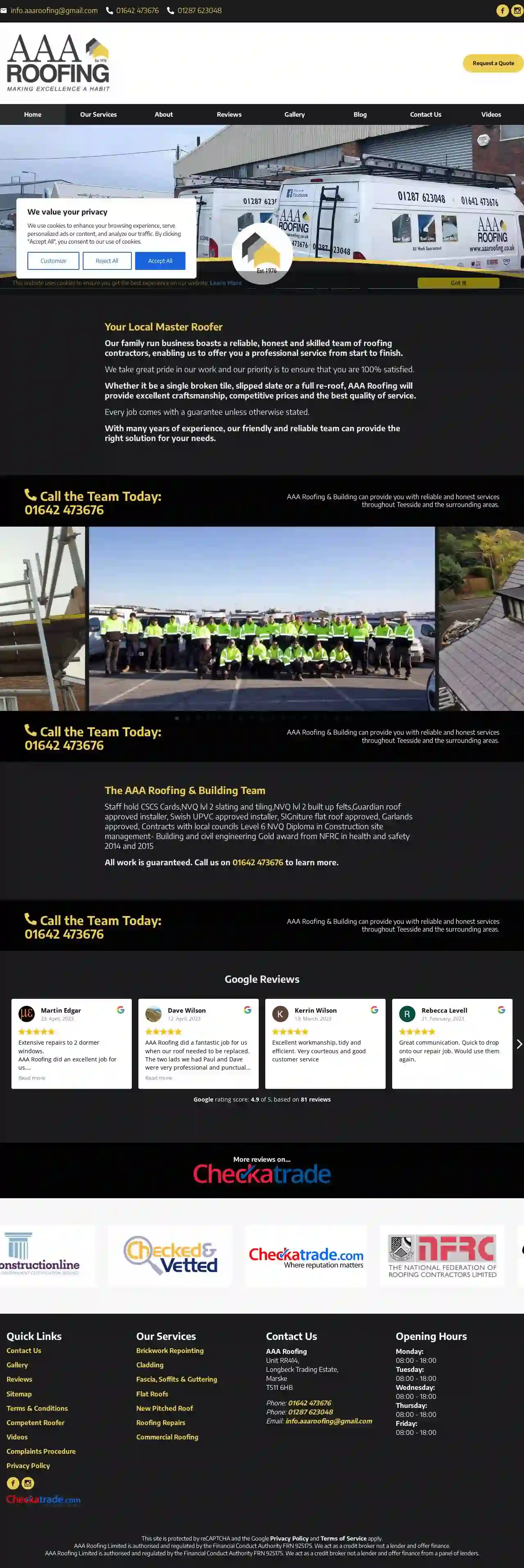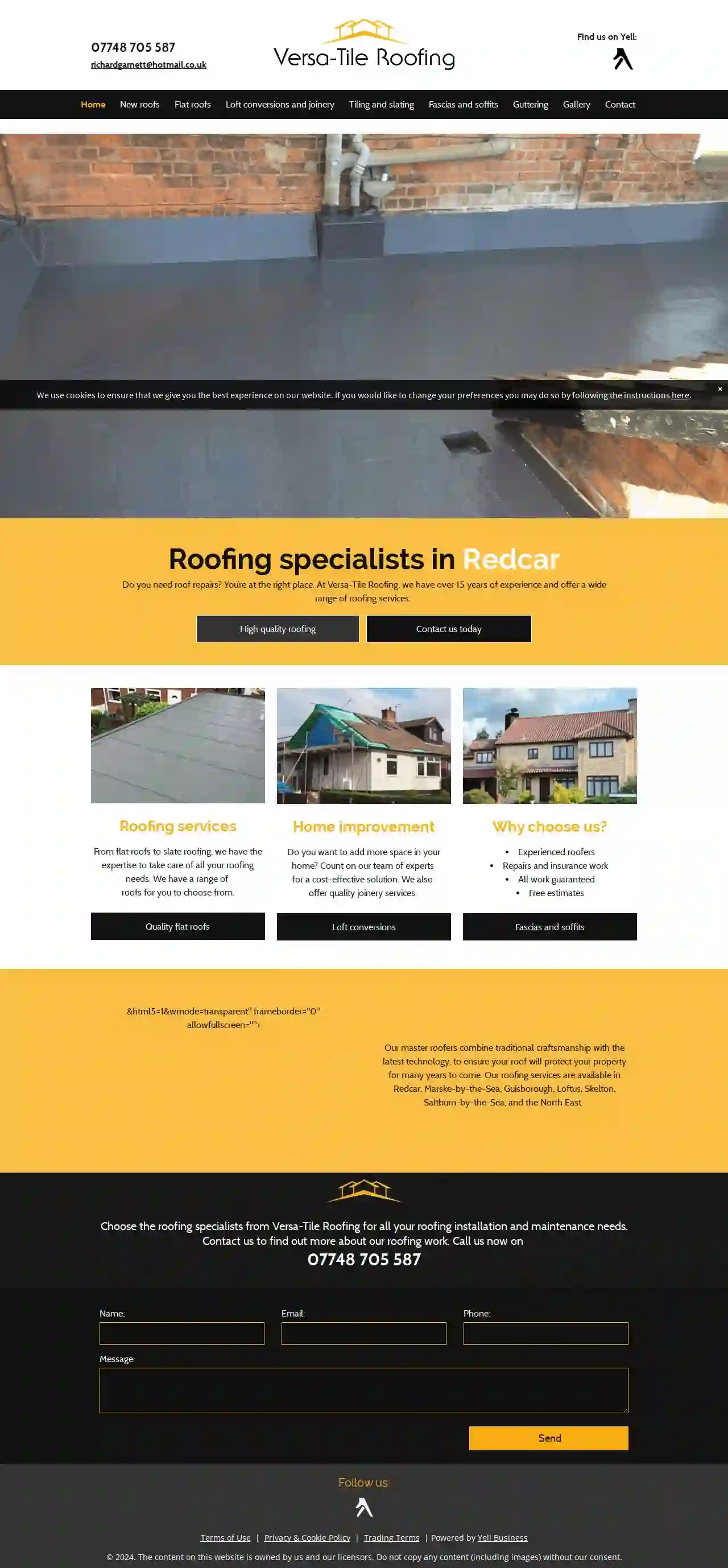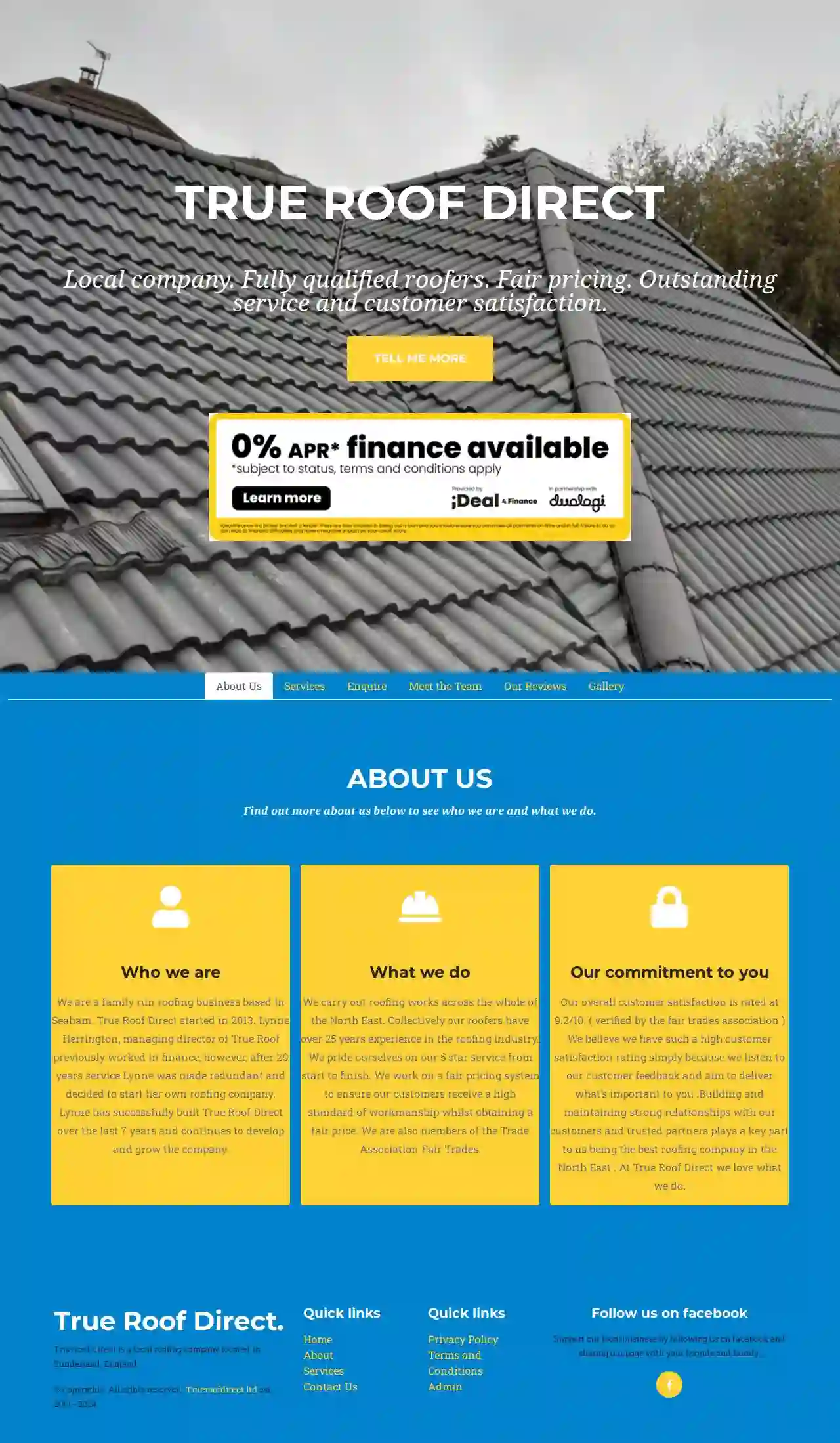Roofing Companies Seaton Carew
Find top Roofing Contractor in Seaton Carew
Get 3 FREE Roofing Company quotes for your project today! Compare profiles, reviews, accreditations, portfolio, etc... and choose the best service.
- He
Henderson Roofing
4.715 reviews1000 S Green Valley Pkwy, Ste 100, Henderson, 89015, GBHenderson Roof is a locally owned and operated roofing company serving the Henderson, NV area. We specialize in residential and commercial roofing services, including new roof installations, roof repairs, and roof replacements. Our team of experienced roofers is dedicated to providing high-quality workmanship and exceptional customer service.
- Services
- Why Us?
- Gallery
Get Quote 
Bennett & Sons
4.744 reviews59 Hornhill Road, Maple Cross, WD3 9TG, GBBennett & Sons are experienced roofers based in Harrow and cover all types of roofing work from minor roof repairs through to complete new pitched roofs. We install high quality flat & pitched roofs, fascias & soffits, bargeboards, guttering, downpipes and cladding as well as all slating, tiling, leadwork and roofing repairs in Harrow, Stanmore, Wembley and all West London. All roofline products are supplied in easy to maintain UPVC, perfectly designed and expertly fitted to complement your home, whether modern or traditional. Our maintenance services include cementing & pointing and UPVC repairs & cleaning to enhance the look of your home and to maintain and preserve its value. We're very proud of the reputation we've earned from local customers in and around Harrow - a reputation for high quality workmanship, excellent results and friendly efficient service. Please call us for a no obligation quote for all types of roofing work.
- Services
- Why Us?
- Gallery
Get Quote
MP Roofing
GBMP Roofing is a professional and highly experienced roofing company based in Durham. We pride ourselves on delivering premium roofing solutions at affordable prices. We serve a wide range of areas across Durham, including Thornley, Sherburn Village, Meadowfield, Shincliffe, Bowburn, and Sacriston. We believe in providing a seamless, enjoyable, and hassle-free experience for every customer. Our team is dedicated to completing every project to the highest standards, taking the time to ensure everything is perfect. We are fully insured, giving you complete peace of mind.
- Services
- Why Us?
- Testimonials
- Gallery
Get Quote
AAA Roofing
Unit RR414, Longbeck Trading Estate, Marske, TS11 6HB, GBOur family run business boasts a reliable, honest and skilled team of roofing contractors, enabling us to offer you a professional service from start to finish. We take great pride in our work and our priority is to ensure that you are 100% satisfied. Whether it be a single broken tile, slipped slate or a full re-roof, AAA Roofing will provide excellent craftsmanship, competitive prices and the best quality of service. Every job comes with a guarantee unless otherwise stated. With many years of experience, our friendly and reliable team can provide the right solution for your needs. Call the Team Today: 01642 473676 AAA Roofing & Building can provide you with reliable and honest services throughout Teesside and the surrounding areas.
- Services
- Why Us?
- Accreditations
- Our Team
- Testimonials
- Gallery
Get Quote
Bailey Building & Roofing Ltd
48 reviewsUnit 1, 10-12, St. Mellons Business Park, Cardiff, CF10 1AA, GBBailey Building Cardiff is a family-run business established in 1988, specializing in roofing and building services in Cardiff and surrounding areas. They pride themselves on providing quality assured service and workmanship, with a wealth of experience in the building and roofing trades. As an approved member of the Federation of Master Builders, they offer certificate of public and employee liability insurance cover. Bailey Building & Roofing Ltd has been recommended and approved by Which?, boasting over 200 testimonials from satisfied customers. They offer a wide range of services, including roofing maintenance and repairs, chimney repairs, building services, extensions, loft conversions, renovations, and complete project management. Bailey Building Cardiff is committed to providing a professional, efficient service with minimal disruption to clients.
- Services
- Why Us?
- Accreditations
- Our Team
- Testimonials
- Gallery
Get Quote
Beechwood Roofing
Unit 10, Acklam Industrial Estate, Middlesbrough, TS5 7AA, GBBeechwood roofing was established in 1989 and have built up a very high reputation for Quality Workmanship in the Domestic and Commercial Industry. We are a roofing company based in Acklam in Middlesbrough. Beechwood Roofing undertakes all aspects of Roofing including Slating , Tiling , Ridging, Converting flat roofs to pitched roofs , Fascias , Soffits , Gutters and Velux Skylights. We are an Approved company with Iko , Icopal , Bauder and Index. We are also Approved by Sarna , Alwitra , Protan for single ply systems. All of our Highly Trained Team are CSCS Registered and our Tradesman are CITB Trained. Beechwood Roofing prides itself on 100% customer satisfaction and Quality Workmanship. A full list of References is available by emailing me at [email protected]
- Services
- Why Us?
- Accreditations
- Our Team
- Testimonials
- Gallery
Get Quote
PB Roofing - Roofers Middlesbrough
53 reviewsMiddlesbrough, GBAt PB Roofing, we take pride in providing high-quality roofing and guttering services to our valued customers. With years of experience in the industry, we have established ourselves as a trusted and reliable name in the field of residential and commercial roofing solutions. Our team of skilled professionals is dedicated to delivering exceptional craftsmanship and outstanding customer service. We understand the importance of a solid and reliable roof for your property, and we strive to exceed your expectations in every project we undertake. PB Roofing can provide you with reliable and honest services throughout Middlesbrough and the surrounding areas. Why Choose Us? Expertise and Experience: Our team consists of highly trained roofing specialists who possess extensive knowledge and expertise in all aspects of roofing and guttering. From installations and repairs to inspections and maintenance, we have the skills to handle a wide range of roofing projects. Quality Materials: We believe that using top-quality materials is essential for achieving long-lasting and durable results. That's why we source our materials from reputable suppliers known for their reliability and durability, ensuring that your roof or gutter system is built to withstand the test of time. Attention to Detail: We pay meticulous attention to every detail of your roofing project. From accurate measurements and precise installations to thorough inspections, we leave no stone unturned to ensure the highest standards of workmanship and reliability. Customer Satisfaction: Our customers' satisfaction is our top priority. We work closely with you, listening to your needs and preferences, and providing personalized solutions that meet your specific requirements. We strive to complete every project on time, within budget, and to your utmost satisfaction. Comprehensive Services: Whether you need a new roof installation, roof repairs, gutter replacement, or general maintenance, we offer a wide range of services to cater to your roofing needs. Our team is equipped with the latest tools and techniques to deliver superior results. If you're looking for reliable and professional roofing and gutter services, trust PB Roofing. We are committed to excellence, and our goal is to provide you with a safe, secure, and aesthetically pleasing roofing solution. Contact us today to schedule a consultation or request a quote. We look forward to serving you. All work is guaranteed. Call us on 07943 880246 to learn more.
- Services
- Why Us?
- Testimonials
- Gallery
Get Quote
Versa Tile Roofing
55 reviews29 Ryehills Drive, Marske-by-the-Sea, TS11 7DN, GBAt Versa-Tile Roofing, we are a team of experienced roofers with over 15 years of experience serving the Redcar area and surrounding towns. We offer a wide range of roofing services, from flat roofs to slate roofing, ensuring we can meet all your roofing needs. Our commitment is to provide high-quality roofing solutions that are both durable and aesthetically pleasing. We pride ourselves on combining traditional craftsmanship with the latest technology to deliver exceptional results. Whether you require roof repairs, new installations, or maintenance, our team of master roofers is here to help. We are dedicated to providing a reliable and cost-effective service, backed by free estimates and all work guaranteed. We serve Redcar, Marske-by-the-Sea, Guisborough, Loftus, Skelton, Saltburn-by-the-Sea, and the wider North East region. Contact us today to discuss your roofing project and let Versa-Tile Roofing be your trusted partner for all your roofing needs.
- Services
- Why Us?
- Gallery
Get Quote
Contemporary Roofline Home Improvements
517 reviews18 Renfrew Road, Sunderland, SR5 5PT, GBEstablished in 2007, Contemporary Roofline is a reputable and trusted home improvement company operating from Sunderland and offering roofline services across the North East of the UK. All our products come with a 10 year guarantee giving our customers quality, commitment and that all important peace of mind. At Contemporary Roofline, we specialise in Fascias, Soffits, Guttering, Gutter roofline repairs, Windows and Doors, Canopies, Rubber roofing, Fencing and Decking. With over 20 years industry experience, Contemporary Roofline offers One-to-One consultations, Professionally trained fitting teams, High Quality workmanship, Customer satisfaction and Free Estimates. If you require gutter installation, replacement or repairs at competitive prices call us today for a free quote. You will not be disappointed
- Services
- Why Us?
- Our Team
- Testimonials
- Gallery
Get Quote
True Roof Direct Ltd
4.538 reviewsSunderland, GBTRUE ROOF DIRECT is a family-run roofing business based in Seaham, established in 2013. Lynne Herrington, the managing director, previously worked in finance for 20 years before starting her own company. True Roof Direct has grown steadily over the past seven years and continues to develop and expand. We pride ourselves on providing a 5-star service from start to finish, ensuring our customers receive high-quality workmanship at a fair price. As members of the Fair Trades Association, we are committed to customer satisfaction, which is reflected in our 9.2/10 rating (verified by the Fair Trades Association). We believe this high rating is a result of listening to customer feedback and delivering what matters most to them. Building strong relationships with our customers and trusted partners is key to our success as the leading roofing company in the North East.
- Services
- Why Us?
- Accreditations
- Our Team
- Gallery
Get Quote
Over 12,314+ Roofers registered
Our roofing experts operate in Seaton Carew and beyond!
Roofyng.co.uk has curated and vetted the Best Roofing Companies in and around Seaton Carew. Find a trustworthy contractor today.
Frequently Asked Questions About Roofing Companies
- Style: Consider your home's architectural style and choose a roofing material that complements it.
- Climate: Factor in your local climate conditions. Some materials perform better in extreme heat, cold, or high winds than others.
- Budget: Roofing materials have a wide range of costs. Determine your budget and choose materials that fit your financial constraints.
- Durability and Lifespan: Assess the expected lifespan and durability of different materials.
- Energy Efficiency: Choose materials with good insulation and reflectivity properties to improve your home's energy efficiency.
How often should I clean my gutters?
How do I choose the right roofing materials for my home?
What is the difference between a roofer and a general contractor?
Roofer: Specializes in roof installations, repairs, and replacements. They have expertise in roofing materials, techniques, and safety practices specific to roofing.
General Contractor: Oversees and manages entire construction projects, including hiring and coordinating subcontractors, such as roofers, electricians, plumbers, etc. They handle overall project planning, scheduling, and budgeting.
For roofing projects, it's generally best to hire a roofing contractor who specializes in roof work.
What is the difference between a roof overlay and a roof tear-off?
Roof Overlay: Installing a new layer of roofing material over the existing roof. It's less expensive and faster, but not always ideal.
Roof Tear-Off: Completely removing the existing roofing before installing a new one. More labor-intensive but allows for inspection and repairs to the roof deck.
A tear-off is typically preferred, but a roofing contractor can advise on the best approach for your situation.
How often should I clean my gutters?
How do I choose the right roofing materials for my home?
- Style: Consider your home's architectural style and choose a roofing material that complements it.
- Climate: Factor in your local climate conditions. Some materials perform better in extreme heat, cold, or high winds than others.
- Budget: Roofing materials have a wide range of costs. Determine your budget and choose materials that fit your financial constraints.
- Durability and Lifespan: Assess the expected lifespan and durability of different materials.
- Energy Efficiency: Choose materials with good insulation and reflectivity properties to improve your home's energy efficiency.
What is the difference between a roofer and a general contractor?
Roofer: Specializes in roof installations, repairs, and replacements. They have expertise in roofing materials, techniques, and safety practices specific to roofing.
General Contractor: Oversees and manages entire construction projects, including hiring and coordinating subcontractors, such as roofers, electricians, plumbers, etc. They handle overall project planning, scheduling, and budgeting.
For roofing projects, it's generally best to hire a roofing contractor who specializes in roof work.
What is the difference between a roof overlay and a roof tear-off?
Roof Overlay: Installing a new layer of roofing material over the existing roof. It's less expensive and faster, but not always ideal.
Roof Tear-Off: Completely removing the existing roofing before installing a new one. More labor-intensive but allows for inspection and repairs to the roof deck.
A tear-off is typically preferred, but a roofing contractor can advise on the best approach for your situation.